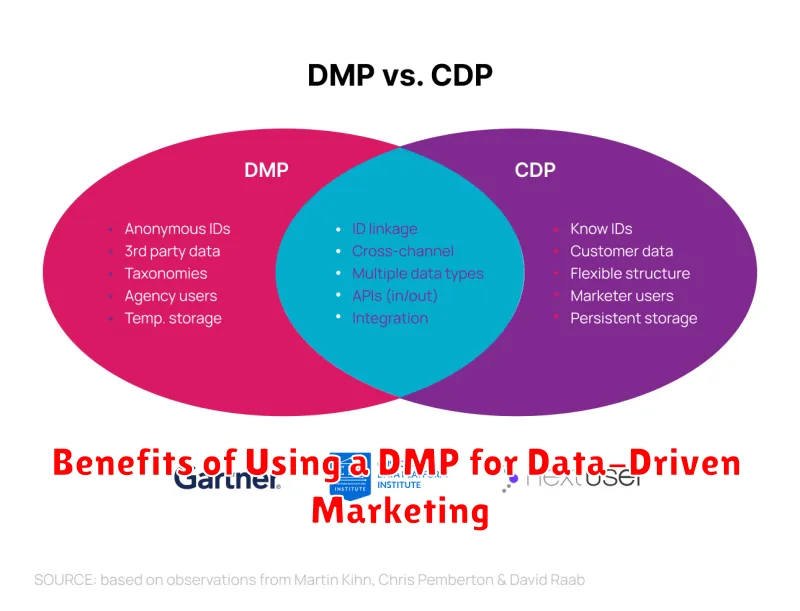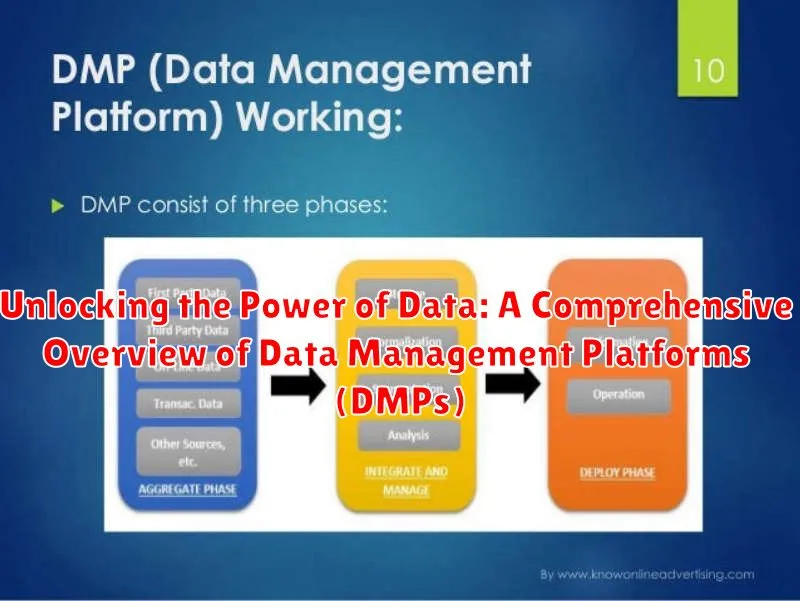In today’s data-driven world, businesses are constantly seeking effective strategies to unlock the power of data. Data Management Platforms (DMPs) have emerged as a critical solution for organizations aiming to centralize, organize, and activate their valuable data assets. This comprehensive overview will delve into the core functionalities of DMPs, exploring how they enable businesses to gain deeper customer insights, improve marketing campaign performance, and ultimately drive revenue growth. Understanding DMPs is no longer a luxury but a necessity for staying competitive in the global marketplace.
This article aims to provide a thorough understanding of Data Management Platforms, outlining their key components, benefits, and practical applications. We will explore how DMPs collect data from various sources, including website traffic, CRM systems, and third-party providers, to create unified customer profiles. By mastering data management principles and leveraging the capabilities of DMPs, organizations can make informed decisions, personalize customer experiences, and achieve a significant return on investment. Get ready to unlock the power of data and transform your business strategy.
What is a Data Management Platform (DMP)?
A Data Management Platform (DMP) is a centralized software platform used for collecting, organizing, and activating first-party, second-party, and third-party audience data from various sources. Its primary function is to unify fragmented data into comprehensive user profiles, enabling marketers and advertisers to create more targeted and effective marketing campaigns.
Essentially, a DMP acts as a data warehouse and insights engine, helping businesses understand their customers better and deliver personalized experiences across multiple channels. This involves:
- Data Collection: Gathering data from various online and offline sources.
- Data Organization: Segmenting and classifying data based on demographics, interests, and behaviors.
- Data Activation: Using the segmented data to target specific audiences with relevant advertisements and marketing messages.
By leveraging a DMP, companies can improve their advertising ROI, enhance customer engagement, and gain a competitive edge in the data-driven marketing landscape.
Key Features and Functionalities of a DMP
Data Management Platforms (DMPs) offer a robust suite of features designed to centralize, organize, and activate audience data. Key functionalities include data collection, which encompasses first-party, second-party, and third-party data ingestion. Data unification is another crucial feature, resolving identity across disparate sources to create a unified customer view.
Segmentation allows marketers to create granular audience segments based on demographics, behaviors, and interests. DMPs also provide audience analytics, offering insights into segment performance and characteristics. Furthermore, activation is a core function, enabling the deployment of these segments across various marketing channels such as programmatic advertising, email marketing, and social media platforms. These features work in concert to enable data-driven marketing strategies.
Benefits of Using a DMP for Data-Driven Marketing

Data Management Platforms (DMPs) offer significant advantages for data-driven marketing initiatives. By centralizing and organizing diverse data sources, DMPs enable marketers to gain a holistic view of their target audience.
Key benefits include:
- Improved Audience Targeting: DMPs facilitate the creation of precise audience segments, leading to more effective ad campaigns.
- Enhanced Personalization: Understanding customer preferences allows for personalized messaging and content delivery.
- Increased ROI: Optimizing ad spend by targeting the right audience results in a higher return on investment.
- Data-Driven Insights: DMPs provide valuable insights into customer behavior, informing marketing strategy.
- Streamlined Campaign Management: Centralized data management simplifies the execution and monitoring of marketing campaigns.
Ultimately, leveraging a DMP empowers marketers to make informed decisions, optimize campaigns, and drive better results.
How Does a DMP Work? A Technical Deep Dive
Data Management Platforms (DMPs) function by aggregating data from various online and offline sources. This data is then used to build detailed user profiles. The core process involves several key stages:
- Data Collection: DMPs ingest data from first-party sources (website, CRM), second-party sources (partner data), and third-party sources (data aggregators).
- Data Processing and Standardization: Raw data is cleaned, standardized, and categorized to ensure consistency and accuracy.
- User Segmentation: The standardized data is used to create audience segments based on various attributes such as demographics, interests, and behaviors.
- Audience Activation: These segments are then activated across various marketing platforms, such as ad exchanges, Demand-Side Platforms (DSPs), and social media platforms.
A crucial aspect is the use of cookies and device identifiers to track users anonymously across different websites and devices. This allows DMPs to build comprehensive user profiles without directly identifying individuals. The entire process adheres to data privacy regulations and anonymization techniques.
DMP vs. CDP: Understanding the Key Differences
While both Data Management Platforms (DMPs) and Customer Data Platforms (CDPs) deal with data, they serve distinct purposes. The key difference lies in the type of data they handle and how that data is used.
DMPs primarily focus on third-party data, often anonymous, used for advertising and audience targeting. They are designed to manage and activate data for marketing campaigns, primarily for customer acquisition. DMPs typically house cookie data to identify and target online users.
In contrast, CDPs concentrate on first-party data, including Personally Identifiable Information (PII), collected directly from customers. CDPs aim to create a unified customer profile for personalized experiences across various touchpoints and throughout the customer lifecycle. CDPs support a wide range of marketing, sales, and service activities.
Here’s a simplified comparison:
- DMP: Third-party data, anonymous, advertising focused
- CDP: First-party data, PII, customer experience focused
Use Cases for DMPs Across Industries
Data Management Platforms (DMPs) offer a multitude of applications across various industries, primarily centered around leveraging data for enhanced decision-making and improved marketing strategies.
E-commerce
In e-commerce, DMPs are used to personalize website experiences, optimize ad targeting, and improve customer segmentation based on browsing history and purchase behavior. They help retailers understand which products and offers resonate with specific customer segments, leading to increased sales and customer loyalty.
Publishing
Publishers utilize DMPs to manage audience data, optimize ad inventory pricing, and deliver targeted content recommendations. By understanding audience interests and demographics, publishers can increase ad revenue and improve user engagement.
Financial Services
Financial institutions leverage DMPs for fraud detection, risk assessment, and personalized financial product recommendations. DMPs help them identify patterns and anomalies in customer data, allowing them to mitigate risks and offer tailored services.
Healthcare
Healthcare providers use DMPs to improve patient engagement, personalize treatment plans, and optimize healthcare marketing campaigns, while adhering to strict data privacy regulations. Understanding patient demographics and preferences allows for more effective communication and improved patient outcomes.
Choosing the Right DMP for Your Business
Selecting the appropriate Data Management Platform (DMP) is a crucial decision that can significantly impact the success of your data-driven marketing initiatives. Several factors should be carefully considered during the evaluation process.
Key Considerations:
- Business Goals: Define your objectives. What marketing challenges are you trying to solve with a DMP?
- Data Sources: Identify the data sources you intend to integrate. Ensure the DMP supports these integrations.
- Scalability: Choose a DMP that can scale with your business growth.
- Integration Capabilities: Evaluate the DMP’s ability to integrate with your existing marketing technology stack.
- Reporting and Analytics: Assess the DMP’s reporting capabilities to ensure you can effectively measure performance.
- Pricing Model: Understand the pricing structure and ensure it aligns with your budget.
- Compliance Features: Verify the DMP has features that align with current regulations.
By carefully evaluating these considerations, you can select a DMP that effectively meets your business needs and maximizes the value of your data.
Data Privacy and Compliance Considerations When Using a DMP

Navigating the landscape of data privacy and compliance is paramount when implementing and utilizing a Data Management Platform (DMP). Organizations must adhere to regulations such as the General Data Protection Regulation (GDPR), the California Consumer Privacy Act (CCPA), and other relevant regional and industry-specific laws.
Key considerations include:
- Data Collection Consent: Ensuring explicit and informed consent is obtained from users regarding data collection and usage.
- Data Security: Implementing robust security measures to protect data from unauthorized access, breaches, and leaks.
- Data Retention Policies: Establishing clear policies regarding how long data is stored and when it is securely deleted.
- Transparency and User Rights: Providing users with clear information about how their data is being used and allowing them to exercise their rights, such as access, rectification, and erasure.
- Vendor Compliance: Verifying that your DMP vendor adheres to relevant data privacy regulations and security standards.
Failure to comply with these regulations can result in significant fines, reputational damage, and legal liabilities. Therefore, a proactive and comprehensive approach to data privacy and compliance is essential for responsible DMP usage.
Future Trends in Data Management Platforms
The landscape of Data Management Platforms (DMPs) is continually evolving, driven by advancements in technology and shifts in consumer behavior. Understanding these emerging trends is crucial for businesses looking to leverage the power of data effectively.
One key trend is the increasing integration of Artificial Intelligence (AI) and Machine Learning (ML). These technologies enhance DMPs by automating tasks such as data segmentation, predictive modeling, and personalized advertising.
Another significant development is the growing emphasis on first-party data. As third-party cookie deprecation becomes more widespread, businesses are prioritizing the collection and utilization of their own data, making DMP integration with Customer Relationship Management (CRM) systems and other first-party data sources increasingly important.
Finally, enhanced data privacy features, aligned with regulations like GDPR and CCPA, are becoming standard. Future DMPs will offer more granular control over data usage and consent management, ensuring compliance and building consumer trust.

